How to Get Rid of Man Breast in a Month
Chances are good you found this article because you think you may have "man boobs."
And, chances are also good you're willing to do just about anything to get rid of them.
And I'd also wager you haven't had much luck so far, and that you're beginning to think that your genetics are to blame and that surgery might be your only option.
According to the American Society of Plastic Surgeons, male breast reduction surgeries increased 32% from 2000 to 2017, and in 2015 men accounted for 40% of all breast reduction surgeries.
Well I've got good news for you:
In most cases, "man boobs" aren't a genetic curse and don't require surgical removal. They're simply caused by having too much total body fat, and once you reduce your body fat percentage by tweaking your diet and exercise habits, your man boobs will disappear along with the rest of your chest fat.
So, if you want to learn how to get rid of man boobs fast , you're in the right place.
In this article, you'll learn . . .
- What man boobs ( moobs ) are
- How to lose chest fat with diet and exercise
- The best exercises to get rid of man boobs
- What Are Man Boobs (Moobs)?
- How to Get Rid of Man Boobs Fast
- How to Lose Chest Fat with Diet and Exercise
- 1. Use an aggressive (but not reckless) calorie deficit.
- 2. Eat a high-protein diet.
- 3. Do a lot of heavy compound weightlifting.
- 4. Strategically use cardio to burn fat faster.
- 5. Take fat loss supplements that actually work.
- The Best Exercises to Get Rid of Man Boobs
- Incline Barbell Bench Press
- Flat Barbell Bench Press
- Barbell Back Squat
- Dumbbell Row
Table of Contents
What Are Man Boobs (Moobs)?
When most people say "man boobs," they're talking about excess fat tissue on a man's chest that gives him the appearance of having female breasts.
The technical term for this condition is pseudogynecomastia .
"Pseudo" means false or fake, "gyne" means having female elements, and "mastia" means growth. So, pseudogynecomastia basically translates to "fake female breast growth," which is a pretty accurate description of what's going on.
You'll also sometimes see "man boobs" referred to as gynecomastia or simply "gyno," but this isn't really the same as pseudogynecomastia.
Real gynecomastia is a medical condition characterized by the growth of male breast tissue—not just fat cells but also the glandular cells that are responsible for producing milk for infants. This is caused by an increase in estrogen, a decrease in testosterone, or as a side effect of some medications, and it should be treated by a medical professional.
True gynecomastia isn't that common among middle-age adults, although it becomes much more likely as you age, with some research showing it can affect up to 65% of men. That said, studies often use multiple definitions of what constitutes gynecomastia, and in many cases what they're describing is probably more akin to pseudogynecomastia.
Gynecomastia also occurs in up to 70% of male teenagers thanks to hormonal changes that occur during puberty, but this is entirely natural, mild, and usually goes away by their late teens or early 20s.
So, when I refer to "man boobs" throughout the rest of this article, I'm talking about pseudogynecomastia—the flabby stuff hanging off yer' pecs.
Want a free custom meal planning tool?
Quickly calculate your calories, macros, and even micros for losing fat and building muscle.

Sending...
Your free stuff is on the way!
Looks like you're already subscribed!
How to Get Rid of Man Boobs Fast
The best and only way to get rid of chest fat and man boobs is to *drumroll* . . .
Reduce your body fat percentage .
That is, reduce the percentage of your total body weight that's fat, or the amount of fat stored in your entire body.
That's exactly what these guys did after diligently following the diet and training techniques I'm going to share with you in a moment:
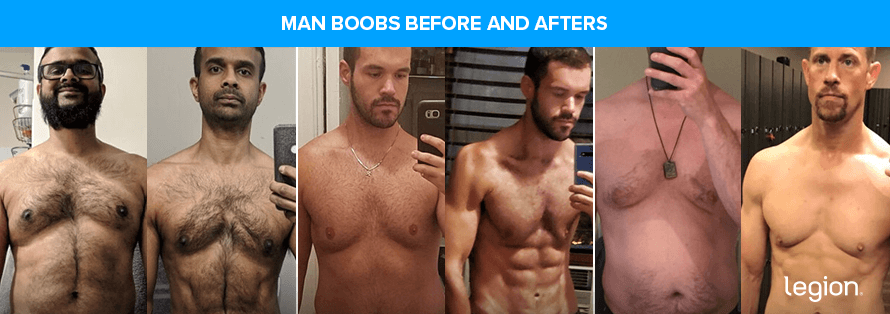
You see, " targeted fat loss "—the idea that you can reduce the fatness of a specific region of your body—doesn't really exist.
When you exercise a muscle group, it does cause fat to be burned around it, but the effect is too small to significantly change your appearance. That's why you'll never lose your moobs by doing push-ups alone (or get abs by doing sit-ups, for that matter).
What you can do, however, is use diet and exercise to reduce your body fat levels and build muscle, both of which will greatly improve the appearance of your chest.
Now, one legitimate gripe about man boobs is that they can be surprisingly stubborn.
Some guy's chest fat will cling on for dear life even after they've lost quite a bit of body fat, largely thanks to their genetics . This is because fat cells around the chest area can be more "resistant" to being mobilized and burned compared to other parts of the body.
The good news is you can still get rid of chest fat no matter how stubborn it is, it just might take you slightly longer than it will for others.
How to Lose Chest Fat with Diet and Exercise
1. Use an aggressive (but not reckless) calorie deficit.
Studies show that the only way to lose chest fat (or any fat for that matter) is to eat fewer calories than you burn.
When you eat fewer calories than you burn, you're in a "calorie deficit" because, well, you're feeding your body fewer calories than it needs. And when you maintain a calorie deficit for long enough, your body is forced to burn through substantial amounts of stored body fat to meet its energy demands. (In other words, weight loss is about calories in versus calories out ).
Now, the larger the calorie deficit, the faster the weight loss, but if you make it too large (by eating too little), you can shoot yourself in the foot by priming yourself for muscle loss and binge eating .
We want to avoid that, but we also want to push the needle so you can slough your moobs as fast as possible.
This is why I recommend that you set your calorie deficit at 20-to-25% (eat 20-to-25% less calories than you burn every day).
If you want to know how many calories you should eat per day to lose weight, use the Legion Calorie Calculator .
If you want to learn more about how many calories you should eat to lose weight, check out this article:
How Many Calories Should I Eat?
(And if you'd like even more specific advice about how many calories, how much of each macronutrient, and which foods you should eat to reach your weight-loss goals, take the Legion Diet Quiz .)
2. Eat a high-protein diet.
When we're talking about body composition , protein is by far the most important macronutrient.
Studies show that eating adequate protein helps you . . .
- Recover faster from your workouts.
- Gain muscle and lose fat faster.
- Retain muscle better while restricting your calories for weight loss.
- Feel more satiated by your meals (and thus be less likely to overeat).
The bottom line is high-protein dieting beats low-protein in every way, especially when you're cutting.
Specifically, you should eat about 1-to-1.2 grams per pound of body weight per day.
And if you're very overweight (25%+ body fat in men and 30%+ in women), then this can be reduced to around 40% of your total calories per day.
If you want to learn more about how much protein you should eat, check out this article:
How Much Protein Do I Need? The Definitive (and Science-Based) Answer
Again, if you feel confused about how many calories, how much of each macronutrient, and which foods you should eat to reach your fitness goals, take the Legion Diet Quiz to learn exactly what diet is right for you.
3. Do a lot of heavy compound weightlifting.
It may seem odd to be talking about heavy compound weightlifting in an article about how to lose man boobs , but lifting weights doesn't just help you build muscle—it helps you lose fat, too.
This is mainly due to the rise in metabolic rate that occurs between sets and after your workout as your body recovers, also known as the "afterburn effect."
By "a lot" of heavy compound weightlifting, I mean three to five times per week.
By "compound," I mean focusing on compound exercises, which are those that target multiple large muscle groups at once, such as the squat , deadlift , and bench and overhead press .
Studies show that these are the types of exercises that produce the greatest increases in metabolic rate, muscle mass, and strength.
And by "heavy," I mean lifting weights that are above 75% of your one-rep max (weights that you can do 12 reps or less with before failing). Research shows that training with heavy weights not only helps you build more muscle, it helps you burn more fat than training with lighter weights.
What's more, you should also strive to add weight or reps to every exercise in every workout. This is known as progressive overload , and it's one of the best ways to maximize the fat-burning effects of weightlifting.
If you want to learn more about the best workout plan for building muscle, check out this article:
Hypertrophy Training: Best Workout Program for Hypertrophy
4. Strategically use cardio to burn fat faster.
The best way to include cardio in a weight loss regimen is to do as little as needed to reach your desired rate of weight loss and stay fit, and no more.
Here's what typically works best:
- Do mostly low- to moderate-intensity cardio like walking or rucking . This will burn plenty of calories, requires very little motivation to complete, and interferes with weightlifting less than high-intensity cardio.
- Do small amounts of HIIT if you enjoy it. You don't actually need to do HIIT as it's no more effective for weight loss than low- to moderate-intensity cardio, but it does offer some fitness benefits you can't get from other kinds of cardio.
- Do at least two easy cardio workouts per week of 20-to-40 minutes each. This is a good starting place for maintaining your health and boosting calorie expenditure.
- Limit the time you spend doing cardio to no more than half the amount of time you spend weightlifting each week. If you lift weights for 4 hours per week, don't do more than 2 hours of cardio per week.
- Do your cardio and weightlifting on separate days if possible, and if you have to do them on the same day, try to separate them by at least 6 hours.
If you want to learn more about how to combine weightlifting and cardio, check out this article:
Concurrent Training: The Right Way to Combine Cardio and Strength Training
5. Take fat loss supplements that actually work.
I saved this for last because it's the least important.
Unfortunately, no amount of weight loss pills and powders are going to make you automagically lose your moobs.
In fact, most fat loss supplements are completely worthless .
But, here's the good news:
If you know how to eat and train to drive fat loss—following the steps we just covered—certain supplements can speed up the process. (And if you'd like to know exactly what supplements to take to reach your fitness goals, take the Legion Supplement Finder Quiz.)
Here are the best supplements for fat loss (including chest fat loss):
- 3-to-6 mg of caffeine per kilogram of body weight per day. This will raise the number of calories you burn and also increases strength , muscle endurance , and anaerobic performance . If you want a clean, delicious source of caffeine that also contains five other ingredients that will boost your workout performance, try Pulse .
- 0.1-to-0.2 milligrams of yohimbine per kilogram of bodyweight before training. This may increase fat loss when used in conjunction with fasted training, and is particularly helpful with losing "stubborn" fat. If you want a 100% natural source of yohimbine that also contains two other ingredients that will help you lose fat faster, preserve muscle, and maintain training intensity and mental sharpness, try Forge .
- One serving of Phoenix per day. Phoenix is a 100% natural fat burner that speeds up your metabolism, enhances fat burning, and reduces hunger and cravings. You can also get Phoenix with caffeine , or without .
The Best Exercises to Get Rid of Man Boobs
When it comes to getting rid of man boobs, most people focus too heavily on chest exercises.
While it's true that doing exercises that train your pecs will improve the appearance of your chest, only doing chest exercises isn't the best way to get rid of man boobs because . . .
- Chest exercises like the bench press don't burn as much fat as exercises that train your entire body, like squats. Since burning more total fat is the best way to get rid of man boobs, increasing full-body exercises in your program is a good idea.
- Neglecting the muscles that help to keep your shoulders back and posture upright can cause your shoulders to round forward. Hunched shoulders and poor posture make the appearance of moobs worse.
So, if you want a workout that'll build your pecs, burn a ton of calories, give you a balanced physique, and help you look less mooby (moobish?), give this a whirl . . .
Incline Barbell Bench Press
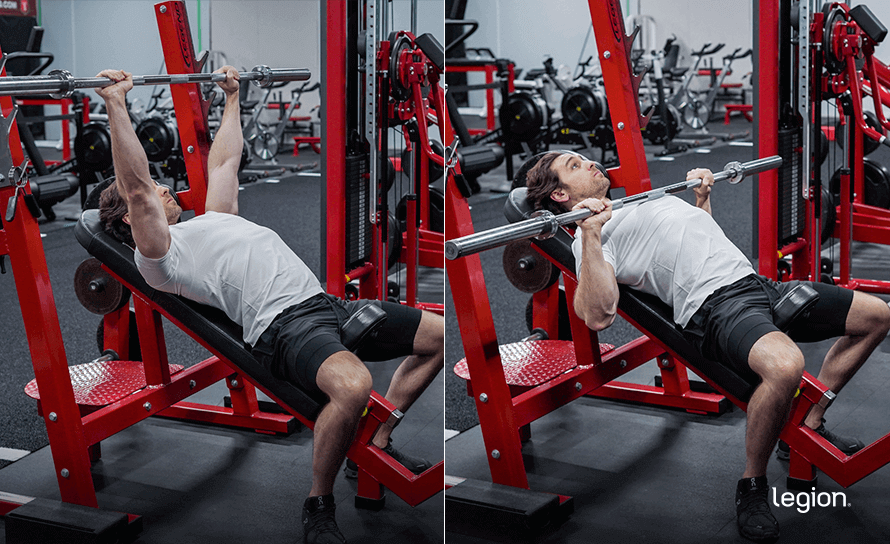
Sets: 3 | Reps: 4-to-6 | Rest: 3-to-5 min
The incline barbell bench press is one of the best exercises for training your "upper chest" which is important because training your upper portion of your pecs will help to even out the "bottom-heavy" look that most guys with man boobs have.
How to: Lie on a bench that's angled at 30 to 45 degrees and place your feet flat on the floor. Pull your shoulder blades together and down, and without lifting your butt or shoulders off the bench, slightly arch your back. Grab the bar with your hands slightly wider than shoulder-width apart, take a deep breath, brace your core, and unrack the barbell.
Bring the barbell to your upper chest, making sure to keep your elbows tucked at about a 45-degree angle relative to your body. When the bar touches your chest, explosively press the bar back to the starting position.
Flat Barbell Bench Press
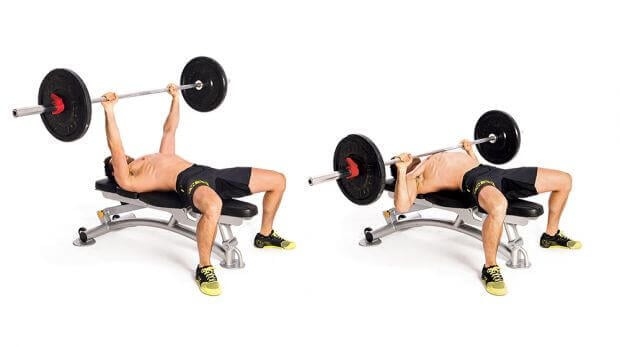
Sets: 3 | Reps: 6-to-8 | Rest: 3-to-5 min
The flat barbell bench press is one of the single best exercises for building almost every major muscle in your upper body, particularly your pecs. This is important because building bigger pecs will improve the overall appearance of your chest, even if you're carrying a little extra fat in that area.
How to: Lie on a flat bench with your feet flat on the floor, directly under your knees. Pull your shoulder blades together and down, and without lifting your butt or shoulders off the bench, slightly arch your back. Grab the bar with your hands slightly wider than shoulder width apart, take a deep breath, brace your core, and unrack the barbell.
Bring the barbell to the middle of your chest, making sure to keep your elbows tucked at about a 45-degree angle relative to your body. When the bar touches your chest, explosively press the bar back to the starting position.
Barbell Back Squat
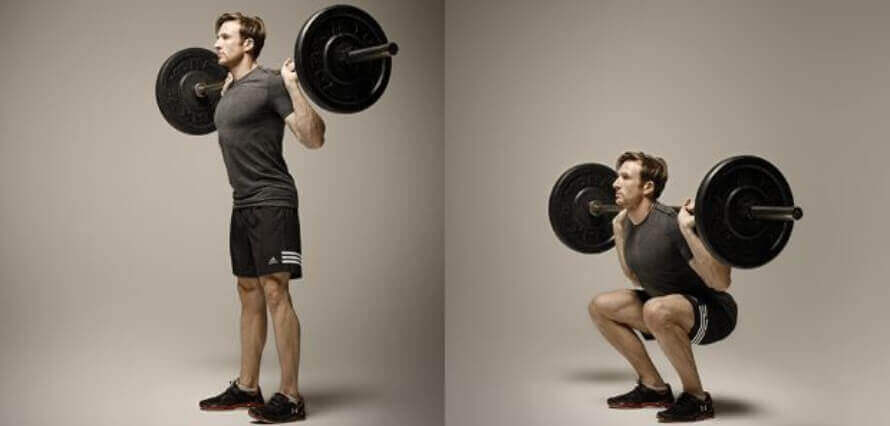
Sets: 3 | Reps: 6-to-8 | Rest: 3-to-5 min
Most people think of the squat as a leg exercise, but it actually trains almost every major muscle group in your body. It also burns a lot of calories, which is important if fat loss is one of your main goals.
How to: Position a barbell in a squat rack at about the height of your nipples. Step under the bar, pinch your shoulder blades together, and rest the bar directly above the bony ridges on the bottom of your shoulder blades. Lift the bar out of the rack, take one or two steps backward, and place your feet a little wider than shoulder-width apart with your toes pointing slightly outward.
Sit down and remember to keep your back straight and push your knees out in the same direction as your toes throughout each rep. Stand up and return to the starting position.
Dumbbell Row
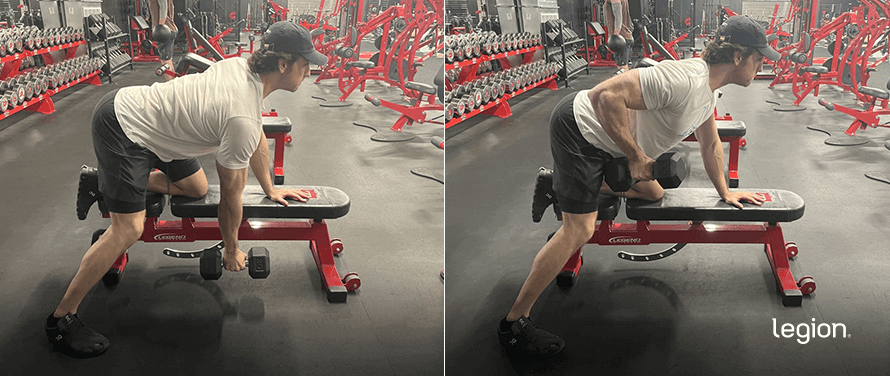
Sets: 3 | Reps: 8-to-10 | Rest: 3-to-5 min
The dumbbell row is a "pull" exercise that trains all the muscles of your back. This is important because it helps you to balance out all of the pressing you did earlier in the workout.
How to: Hold a dumbbell in your right hand. Bend over and put your left hand and left knee on a bench, chair, windowsill, etc. that's about knee height off the ground. Keep your right foot planted on the floor and let your right arm (the one holding the dumbbell) extend toward the floor. Keeping your back straight, pull the dumbbell upward until it touches your torso.
Return the dumbbell to the starting position. Once you've completed the desired number of reps, repeat the process with your left arm.
+ Scientific References
- M J Millan, A Newman-Tancredi, V Audinot, D Cussac, F Lejeune, J P Nicolas, F Cogé, J P Galizzi, J A Boutin, J M Rivet, A Dekeyne, & A Gobert. (n.d.). Agonist and antagonist actions of yohimbine as compared to fluparoxan at alpha(2)-adrenergic receptors (AR)s, serotonin (5-HT)(1A), 5-HT(1B), 5-HT(1D) and dopamine D(2) and D(3) receptors. Significance for the modulation of frontocortical monoaminergic transmission and depressive states - PubMed. Retrieved July 2, 2021, from https://pubmed.ncbi.nlm.nih.gov/10611634/
- Ostojic, S. M. (2006). Yohimbine: The effects on body composition and exercise performance in soccer players. Research in Sports Medicine, 14(4), 289–299. https://doi.org/10.1080/15438620600987106
- Beck, T. W., Housh, T. J., Schmidt, R. J., Johnson, G. O., Housh, D. J., Coburn, J. W., & Malek, M. H. (2006). The acute effects of a caffeine-containing supplement on strength, muscular endurance, and anaerobic capabilities. Journal of Strength and Conditioning Research, 20(3), 506–510. https://doi.org/10.1519/18285.1
- Astorino, T. A., Rohmann, R. L., & Firth, K. (2008). Effect of caffeine ingestion on one-repetition maximum muscular strength. European Journal of Applied Physiology, 102(2), 127–132. https://doi.org/10.1007/s00421-007-0557-x
- Astrup, A., Toubro, S., Cannon, S., Hein, P., Breum, L., & Madsen, J. (1990). Caffeine: A double-blind, placebo-controlled study of its thermogenic, metabolic, and cardiovascular effects in healthy volunteers. American Journal of Clinical Nutrition, 51(5), 759–767. https://doi.org/10.1093/ajcn/51.5.759
- Keating, S. E., Johnson, N. A., Mielke, G. I., & Coombes, J. S. (2017). A systematic review and meta-analysis of interval training versus moderate-intensity continuous training on body adiposity. In Obesity Reviews (Vol. 18, Issue 8, pp. 943–964). Blackwell Publishing Ltd. https://doi.org/10.1111/obr.12536
- Marx, J. O., Ratamess, N. A., Nindl, B. C., Gotshalk, L. A., Volek, J. S., Dohi, K., Bush, J. A., Gómez, A. L., Mazzetti, S. A., Fleck, S. J., Häkkinen, K., Newton, R. U., & Kraemer, W. J. (2001). Low-volume circuit versus high-volume periodized resistance training in women. Medicine and Science in Sports and Exercise, 33(4), 635–643. https://doi.org/10.1097/00005768-200104000-00019
- Farinatti, P. T. V., & Castinheiras Net, A. G. (2011). The effect of between-set rest intervals on the oxygen uptake during and after resistance exercise sessions performed with large-and small-muscle mass. Journal of Strength and Conditioning Research, 25(11), 3181–3190. https://doi.org/10.1519/JSC.0b013e318212e415
- Fatouros, I. G., Chatzinikolaou, A., Tournis, S., Nikolaidis, M. G., Jamurtas, A. Z., Douroudos, I. I., Papassotiriou, I., Thomakos, P. M., Taxildaris, K., Mastorakos, G., & Mitrakou, A. (2009). Intensity of resistance exercise determines adipokine and resting energy expenditure responses in overweight elderly individuals. Diabetes Care, 32(12), 2161–2167. https://doi.org/10.2337/dc08-1994
- Halton, T. L., & Hu, F. B. (2004). The effects of high protein diets on thermogenesis, satiety and weight loss: A critical review. Journal of the American College of Nutrition, 23(5), 373–385. https://doi.org/10.1080/07315724.2004.10719381
- Helms, E. R., Aragon, A. A., & Fitschen, P. J. (2014). Evidence-based recommendations for natural bodybuilding contest preparation: Nutrition and supplementation. In Journal of the International Society of Sports Nutrition (Vol. 11, Issue 1, pp. 1–20). BioMed Central Ltd. https://doi.org/10.1186/1550-2783-11-20
- Evans, E. M., Mojtahedi, M. C., Thorpe, M. P., Valentine, R. J., Kris-Etherton, P. M., & Layman, D. K. (2012). Effects of protein intake and gender on body composition changes: A randomized clinical weight loss trial. Nutrition and Metabolism, 9(1). https://doi.org/10.1186/1743-7075-9-55
- Tipton, K. D., & Ferrando, A. A. (2008). Improving muscle mass: Response of muscle metabolism to exercise, nutrition and anabolic agents. Essays in Biochemistry, 44, 85–98. https://doi.org/10.1042/BSE0440085
- Phillips, S. M., & van Loon, L. J. C. (2011). Dietary protein for athletes: From requirements to optimum adaptation. Journal of Sports Sciences, 29(SUPPL. 1). https://doi.org/10.1080/02640414.2011.619204
- Hand, G. A., Shook, R. P., Paluch, A. E., Baruth, M., Crowley, E. P., Jaggers, J. R., Prasad, V. K., Hurley, T. G., Hebert, J. R., O'Connor, D. P., Archer, E., Burgess, S., & Blair, S. N. (2013). The energy balance study: The design and baseline results for a longitudinal study of energy balance. Research Quarterly for Exercise and Sport, 84(3), 275–286. https://doi.org/10.1080/02701367.2013.816224
- Stallknecht, B., Dela, F., & Helge, J. W. (2007). Are blood flow and lipolysis in subcutaneous adipose tissue influenced by contractions in adjacent muscles in humans? American Journal of Physiology - Endocrinology and Metabolism, 292(2). https://doi.org/10.1152/ajpendo.00215.2006
- Lemaine, V., Cayci, C., Simmons, P., & Petty, P. (2013). Gynecomastia in adolescent males. Seminars in Plastic Surgery, 27(1), 56–61. https://doi.org/10.1055/s-0033-1347166
- Kanakis, G. A., Nordkap, L., Bang, A. K., Calogero, A. E., Bártfai, G., Corona, G., Forti, G., Toppari, J., Goulis, D. G., & Jørgensen, N. (2019). EAA clinical practice guidelines—gynecomastia evaluation and management. Andrology, 7(6), 778–793. https://doi.org/10.1111/andr.12636
Readers' Ratings
4.94/5 (31)
Your Rating?
How to Get Rid of Man Breast in a Month
Source: https://legionathletics.com/man-boobs/